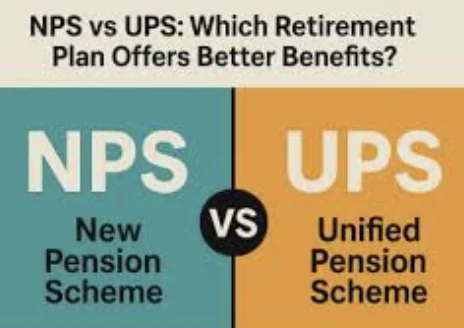UPS versus NPS key differences

UPS versus NPS
Here is a concise summary of the key differences between the Unified Pension Scheme (UPS) and the National Pension System (NPS) based on recent 2025 data:
| Feature | Unified Pension Scheme (UPS) | National Pension System (NPS) |
| Type of Scheme | Hybrid; guaranteed fixed pension with contribution model | Defined Contribution; market-linked pension scheme |
| Applicable To | Central government employees (may extend to state employees) | Government & private sector employees, NRIs, self-employed |
| Employee Contribution | 10% of basic salary + DA | Typically 10% of basic salary + DA |
| Government Contribution | 18.5% of basic salary + DA | 14% of basic salary + DA |
| Pension Calculation | Guaranteed pension equal to 50% of average last 12 months’ basic pay (for 25+ years of service) | Depends on accumulated corpus and annuity plan; market linked |
| Lump Sum Payment | Fixed lump sum (1/10th of last salary for every 6 months of service) | Up to 60% of corpus tax-free withdrawal allowed |
| Family Pension | 60% of pension payable to family | Depends on annuity plan chosen |
| Inflation Adjustment | Yes, linked to inflation indices (DA revision) | No automatic inflation adjustment |
| Risk Factor | No market risk; assured returns | Exposure to market risk; returns vary with markets |
| Portability | More restricted; primarily for government employees | Highly portable across jobs and sectors |
| Tax Benefits | Not yet fully clarified, expected to be similar or limited | Deductions under 80C, 80CCD(1B), and 80CCD(2) |
| Flexibility | Limited flexibility; fixed benefits | Flexibility in investment choice and fund managers |
Summary
- UPS offers stable, guaranteed pension benefits with inflation protection, ideal for employees seeking predictable post-retirement income without exposure to market risk.
- NPS offers a market-linked pension with potential for higher returns but involves investment risk, suitable for those comfortable with market fluctuations and seeking flexibility.
- Government contribution is higher in UPS (18.5%) compared to NPS (14%).
- Lump sum and family pension benefits vary, with UPS providing assured family pension and fixed lump sum, while NPS benefits depend on accumulated corpus and selected annuity.



Your blog is a testament to your dedication to your craft. Your commitment to excellence is evident in every aspect of your writing. Thank you for being such a positive influence in the online community.
Thank you for the auspicious writeup It in fact was a amusement account it Look advanced to more added agreeable from you By the way how could we communicate
Fantastic site A lot of helpful info here Im sending it to some buddies ans additionally sharing in delicious And naturally thanks on your sweat
Wonderful beat I wish to apprentice while you amend your web site how could i subscribe for a blog web site The account aided me a acceptable deal I had been a little bit acquainted of this your broadcast provided bright clear idea